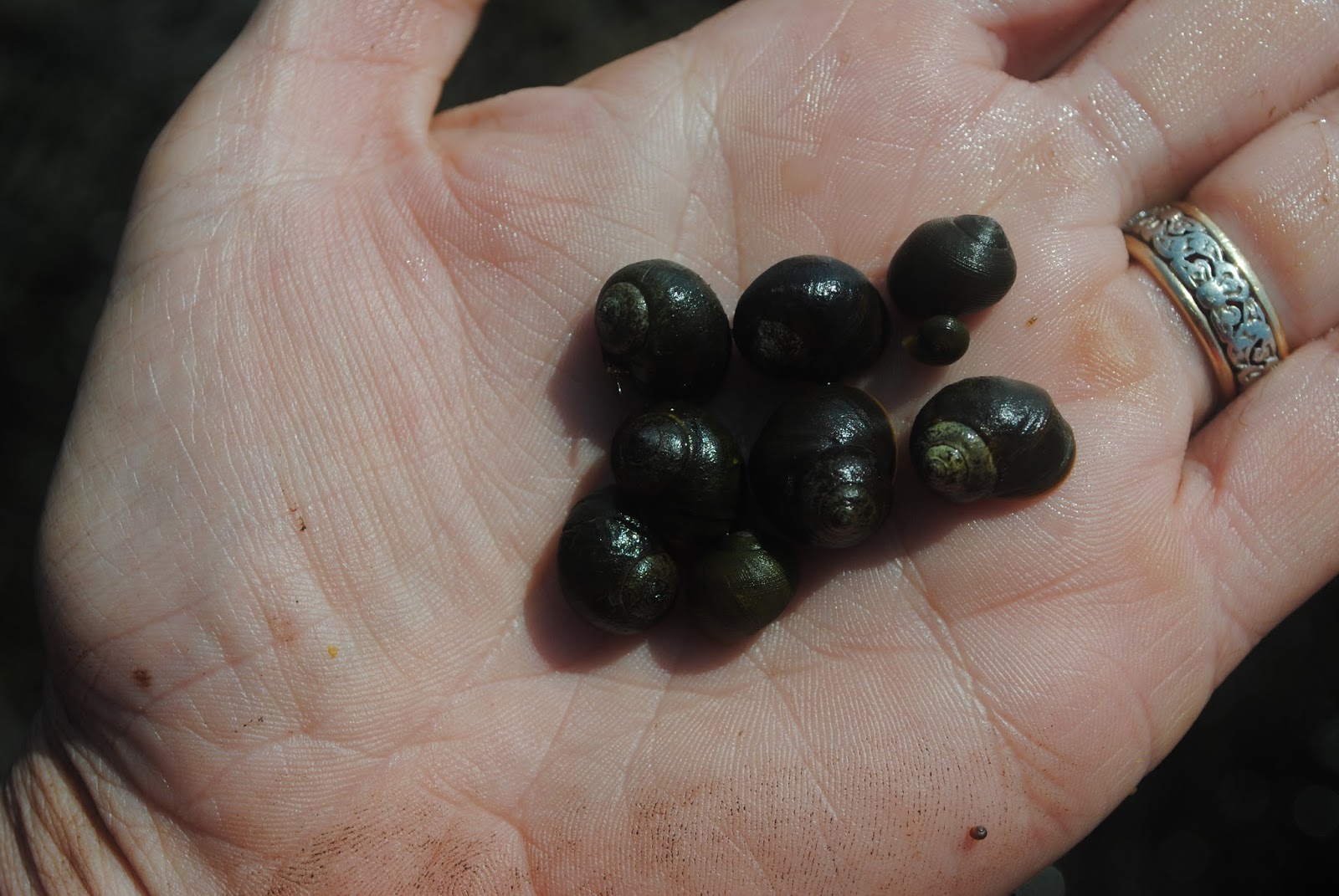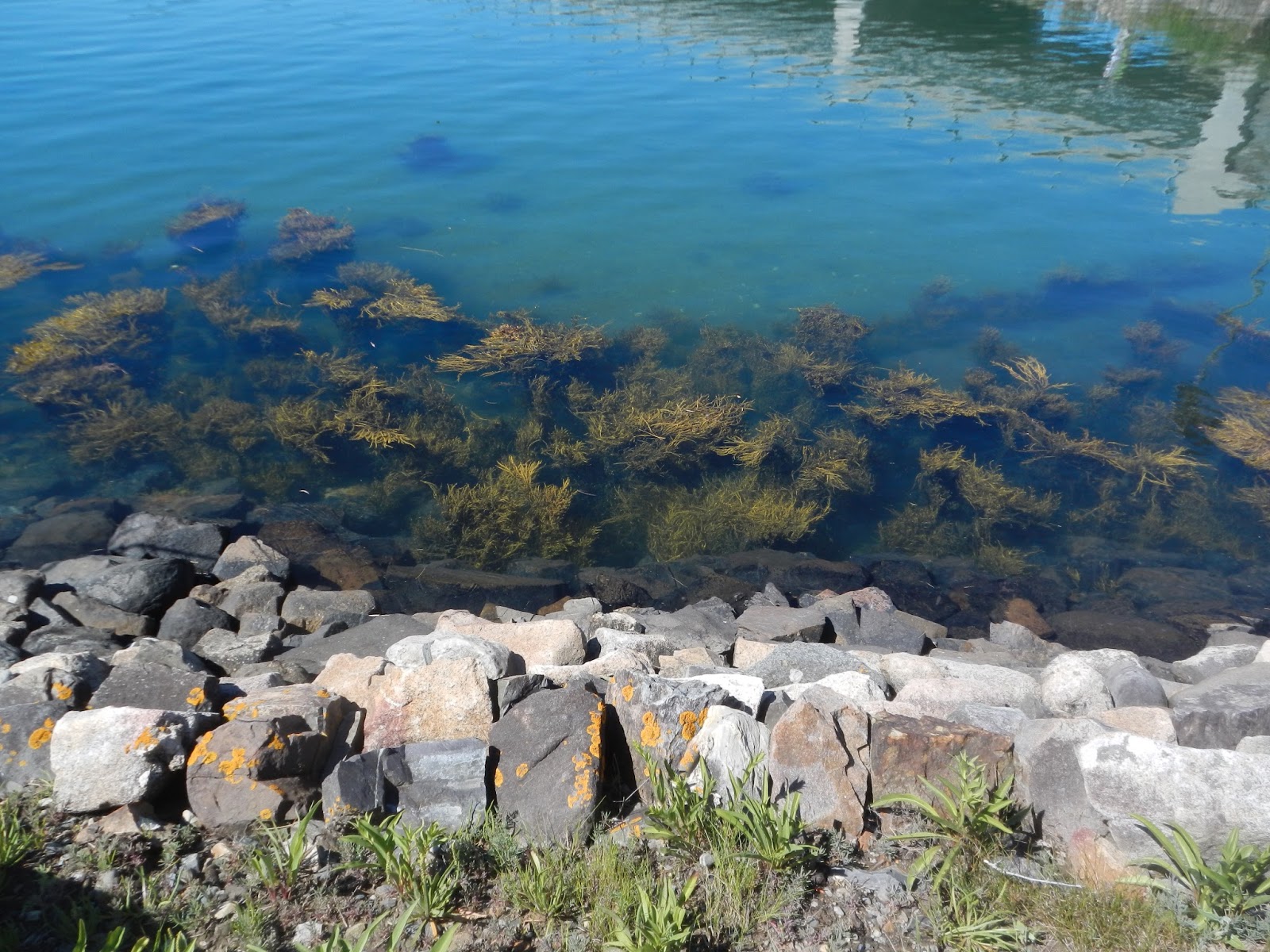 |
 |
It's not unusual for knotted wrack fronds to be fifteen or more years old, and for their holdfasts to live for decades, or maybe even centuries. (A holdfast is where marine algae attaches to the substrate. Seaweed doesn't have roots; rather, their tough holdfasts grab onto rocks, mussels, or other solid objects.) When a frond breaks, it regenerates from the holdfast. Next time you look at a holdfast, realize it might be older than you. Or your parents. Or your grandparents!
 |
Knotted wrack lays down one air bladder each growing season. That makes figuring out how old a frond is easy.
3. Individual knotted wrack fronds can grow meters long -- but very, very slowly.
See? (Note, fronds are much smaller at sites with more wave exposure than at wave-protected sites. This was taken at a site where waves only occur in the worst of storms.) It's amazing to think knotted wrack grows only about 10 cm a year (two and a half inches) and makes it to these great lengths.
4. Knotted wrack creates a cooling canopy over the rocky intertidal at low tide.
The intertidal portion of the coast is a very stressful place for ocean organisms. All of the algae and animals we find in the intertidal are derived from ancestors in the sea. Emerging out of the sea places great physiological stress on them -- especially thermal stress and desiccation. Amazingly, the rocky intertidal habitat is a very hot place in summer -- too hot for comfort if you're an intertidal organism. But Ascophyllum provides cooling shade and a moist canopy, protecting the species under it from overheating. In summer, temperatures under an algal canopy of knotted wrack can be 5-10 degrees (F) lower than without it. (It's also warmer in winter, preventing organisms from freezing.) This is particularly important in the high intertidal.
5. Knotted wrack reduces wave impacts on organisms living under the canopy.
The energy required to hold on when a wave hits the beach can be substantial. Knotted wrack can act as a wave buffer, allowing organisms to put more energy into other activities -- like growing and having babies.
6. Knotted wrack is an ecosystem engineer that fundamentally influences the community of organisms around it.
Knotted wrack has such a large influence on the community around it that it can be thought of as an ecosystem engineer or foundation species, just like coral reefs or sea otters are. The habitat around knotted wrack changes fundamentally simply because it is there. Without knotted wrack, it's a place where the sun bakes the substrate at low tide, the waves wash away organisms at high tide, and space for growing is limited. With knotted wrack, it's a cool(er), wave-buffered, complex habitat with lots of things to hold onto and grow. Knotted wrack's long fronds -- that persist for decades -- influence their surroundings greatly. Everything from sponges, crabs, nudibranchs and snails to barnacles, smaller seaweeds adapted to low-light conditions, mussels and limpets find a comfy home under the knotted wrack layer. Knotted wrack also provides substrate for other organisms to grow on -- other seaweeds, worms and snails all live on the seaweed itself. Predators like gulls have a harder time finding tasty morsels like crabs when they're hidden in knotted wrack too. However, knotted wrack isn't all good -- it can easily sweep other organisms away (especially babies just settled out of the plankton).
7. Knotted wrack spores are wimpy.
Despite the dominance of giant knotted wrack stands all over Maine's coast, their spores (like seeds) aren't very robust. Knotted wrack reproduces by making spores that move with the currents and eventually settle on the best hard substrate they can find. If this substrate happens to be exposed to waves -- even small ones -- the spores simply can't hold on. That's why it's common to see vast stretches of protected bays blanketed in knotted wrack, but uncommon to see it on exposed headlands.
8. Littorina obtusata -- a beautiful little snail -- lives in knotted wrack.
Smooth perwinkles -- Litterina obtusata -- lives exclusively on knotted wrack fronds. They eat both the knotted wrack itself, and epiphytes that grow on knotted wrack. Rumor has it they even lay their eggs in the air bladders, but I've never seen it myself.
9. Eiders forage in knotted wrack, and their babies hide in it.
I've got a soft spot for common eiders. Kent Island, where I spend my summers, was bought by Sterling Rockefeller in 1930 to save the last known nesting eider population in the Gulf of Maine. There were less than 30 nesting pairs in the entire Gulf of Maine at the time, almost all of them breeding on Kent Island. Rockefeller sold Kent Island to Bowdoin College for a dollar not long afterwards, with the stipulation it would be used as a wildlife sanctuary and research facility. You can read about this interesting story here.
Eiders are sea ducks that live in large aggregations during the breeding season, nesting on islands. During this time they forage in knotted wrack for small invertebrates, like snails (see #8) or mussels. Baby eiders head out into the ocean very early in their life -- 12 to 48 hours after hatching, and are highly vulnerable to predation by gulls and eagles. Hiding is an important strategy to survive another day, and baby eiders are pretty good at it, hunkering down in the knotted wrack fronds along the shoreline.
10. Knotted wrack forms a structurally complex underwater forest at high tide.
It might seem, to terrestrial observers like you and I, that knotted wrack just lays there on the bottom. But we should remember that what we see of the intertidal is only half the story -- the low tide half. When the tide is in, knotted wrack is bouyed into a thicket of fronds, nothing like what we expect.
Interested in knotted wrack (who wouldn't be)? You can find it in almost any coastal site that's protected from waves. Some good places to investigate it are Bowdoin College's Coastal Studies Center in Harpswell, Ocean Point in East Boothbay, or Wolfe's Neck State Park. Wear shoes that can get wet and use caution; walking on knotted wrack can be tricky. But get out there, look under those fronds, and have fun. Just do it at low tide.









Very interesting..the things we can learn about other things that we take for granted..and #11..knotted wrack can be very naughty when wrapped around an outboard motor propeller..
ReplyDeleteHa! I feel your pain! Been there, done that! Good point.
ReplyDeleteI love Knotted Wrack too! I love to paint it : ) and I learned some great new things from your blog. Smooth Periwinkles are also so beautiful - and Common Eiders too. Thank you - very interesting read!
ReplyDeleteFantastic article on A. nodosum! You really make it interesting and relevant, and give it a bit of personality. Loved reading this :)
ReplyDeleteI really enjoyed your blog post
ReplyDeleteI'm impressed by how much knotted wrack contributes to its environment.
ReplyDelete